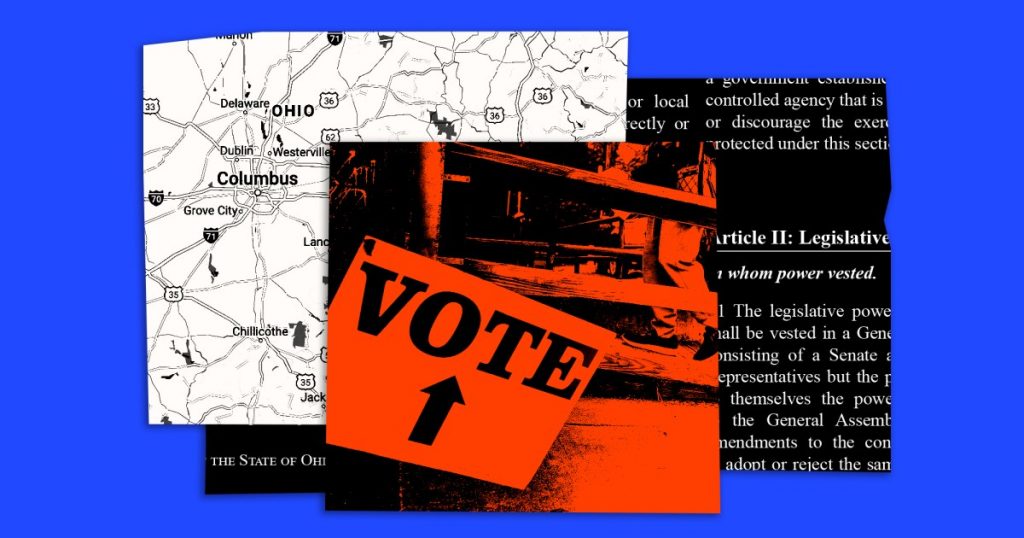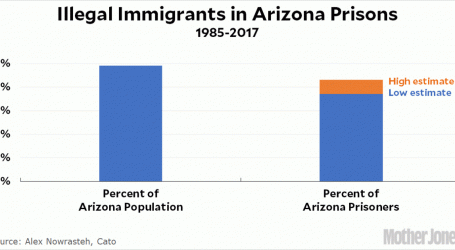The GOP’s Stealth Plan to End Direct Democracy in Ohio
Mother Jones; Joshua Lott/AFP
Fight disinformation: Sign up for the free Mother Jones Daily newsletter and follow the news that matters.In February 1912, former President Teddy Roosevelt traveled to Columbus, Ohio, to endorse an effort to amend the state’s constitution through citizen-led ballot initiatives.
“I believe in the initiative and the referendum, which should be used not to destroy representative government, but to correct it whenever it becomes misrepresentative,” Roosevelt said. “In actual practice it has been found in very many states that legislative bodies have not been responsive to the popular will. Therefore, I believe that the state should provide for the possibility of direct popular action in order to make good such legislative failure.”
That fall, Ohio voters ratified the initiative process as part of a larger national push for reform at a time when 1 percent of the population controlled half the nation’s wealth and corporate robber barons had a stranglehold on state and national politics.
But more than a century later, representative government in Ohio is facing an unprecedented threat.
On Tuesday, August 8, Ohio voters will decide the fate of a ballot initiative that would effectively bar nearly all future initiatives. The vote is occurring because the state’s GOP-controlled legislature—where Republicans have a two-thirds supermajority in both chambers thanks to extreme partisan gerrymandering—decided to hold a special election in August that will determine whether Ohio becomes the toughest state in the country to pass a citizen-led initiative. “It gets rid of the last vestige of accountability for a gerrymandered legislature,” says David Pepper, the former chair of the Ohio Democratic Party and author of Laboratories of Autocracy: A Wake-Up Call from Behind the Lines.
Issue 1, as it is blandly known, would change the threshold for passing a ballot initiative from a simple majority vote to a 60 percent supermajority, allowing a 41 percent minority to block policies favored by a 59 percent majority. To place an initiative on the ballot, organizers would have to gather signatures from 5 percent of voters in all of the state’s 88 counties instead of the 44 currently required. That could allow Ohio’s smallest county, representing just .1 percent of the state’s population, to block the wishes of 87 other counties. The proposal would also eliminate the period when groups can correct faulty signatures, making it easier to disqualify prospective initiatives. The campaign opposing Issue 1, which includes good government groups, business leaders, and four former state governors, has run ads showing a pair of scissors slicing apart the state constitution, saying it would “end majority rule in Ohio, undermining the sacred principle of one person, one vote.”
If that wasn’t bad enough, Republicans placed the initiative on the ballot in early August, when many people are on vacation and students are out of town, in order to sneak it through with little public scrutiny. They chose that date largely to block a ballot initiative in November that would protect reproductive rights. There hasn’t been an August vote on a statewide ballot measure in Ohio in 100 years. “Their goal is to have an artificial majority on Election Day through a low turnout election in August,” Pepper says.
Issue 1 is part of a broader national effort by Republicans to nullify direct democracy after voters in six states safeguarded reproductive rights at the ballot box in 2022 in the wake of the Supreme Court’s decision overturning Roe v. Wade. Fifty measures have been introduced in 14 states this year that would make the initiative process more difficult, according to the Ballot Initiative Strategy Center.
In his majority opinion in Dobbs v. Jackson Women’s Health Organization, Justice Samuel Alito claimed he was simply returning “the issue of abortion to the people’s elected representatives’ in the states.” But today leading figures in the conservative movement—who tried to overturn the 2020 election, helped bankroll the insurrection, and funded an unprecedented number of candidates who opposed free and fair elections in 2022—are trying to decimate democracy at the state level. They see Ohio as a test case for taking their strategy national. “They know that the people are a threat to their power in statehouses,” Pepper says. “If they succeed here, they’ll use it as a national playbook.”
Ohio Republicans claim that Issue 1 is intended “to “protect our state’s founding document from well-funded, out-of-state special interests.” But that more accurately describes their allies who are funding the campaign to pass it.
The largest individual donor to the Issue 1 cause has been the far-right megadonor Richard Uihlein, the reclusive founder of an Illinois-based shipping supply company who was one of the top backers of the “Save America” rally that preceded the insurrection and who has funded scores of candidates and groups promoting election denialism. Uihlein was the GOP’s biggest donor in 2022—and 80 percent of his contributions went to Republicans who denied or questioned the 2020 election results, such as Pennsylvania gubernatorial candidate Doug Mastriano and Nevada secretary of state candidate Jim Marchant.
The push to pass Issue 1 was stalled in the Ohio statehouse amid internal GOP divisions until Uihlein gave $1.1 million this spring to the newly formed Save Our Constitution PAC to pressure Republicans to place it on the August ballot. The group ran ads claiming that dissident Republicans wanted to “hand over control of Ohio’s Constitution to radical liberals, putting our conservative values at risk forever.”
Six Republican legislators targeted by the Uihlein funded television and radio ads— including House Speaker Jason Stephens—soon came out in support of Issue 1, allowing it to narrowly pass the 60 percent threshold needed for the legislature to place a referendum on the ballot.
When the bill received a hearing in the legislature, the only person who testified in favor of it was a representative from an obscure think tank in Florida, the Foundation for Government Accountability, that received nearly $18 million from Uihlein. The FPA has led the behind-the-scenes push to limit direct democracy throughout the country.
Once Issue 1 was placed on the ballot, Uihlein donated nearly all of the funding—$4 million in total—to a new organization, Protect Our Constitution, that has led the push to pass it. The group has run TV ads claiming that Ohio’s constitution is “way too easy to amend” and allows “special interests” dominated “by corporate greed” to take away “our fundamental rights.” The ads do not disclose that an Illinois-based corporate billionaire funded them. (Despite the group’s claim that Ohio’s constitution is too easy to amend, only 19 of 71 citizen-led initiatives have passed since 1912.)
Another $5 million in support of Issue 1 has come from the anti-choice Protect Women Ohio Action, which has run ads ludicrously claiming that opponents of Issue 1 want to “put trans ideology in classrooms and encourage sex changes for kids.” The group has received nearly all of its funding—$5 million out of $5.2 million —from The Concord Fund, a Washington D.C. based group known publicly as the Judicial Crisis Network that is closely linked to Federalist Society co-chair Leonard Leo and has been instrumental in orchestrating the conservative takeover of the courts at the national and state level.
The group’s sister organization, Protect Women Ohio, has received the bulk of its funding from anti-choice Susan B. Anthony Pro-Life America, which has worked closely with the dark money group Heritage Action for America to pass voter suppression bills at the state level.
Another favorite candidate of the right’s dark money network, Arizona gubernatorial candidate Kari Lake, whose lawyers were sanctioned for spreading lies about the 2022 election, plans to campaign for Issue 1 in Ohio on Monday.
The millions in outside funding appears to be having an impact. For weeks, opponents of Issue 1 had outraised supporters, but that changed in the past week, with Ohioans bombarded by TV ads supporting the initiative. Most polls now show it’s a dead heat.
For months, proponents of Issue 1 claimed it wasn’t about abortion, only to admit behind closed doors that it actually was.
“It’s 100% about keeping a radical pro-abortion amendment out of our constitution,” GOP Secretary of State Frank LaRose, a leading supporter of Issue 1, said at a Republican meeting in May in comments that subsequently became public.
In states similar to Ohio, like Michigan and Kansas, measures to protect reproductive rights easily passed with a majority vote, but fell short of the 60 percent threshold that Ohio Republicans want to institute. One new poll showed that 59 percent of Ohioans supported a proposal to legalize abortion, which would fail to pass under the GOP’s new rules.
Indeed, few successful efforts to amend Ohio’s constitution have cleared that hurdle. The vote to add an initiative process in 1912 only received 57 percent of the vote and measures that one would have expected to pass overwhelmingly, such as removing the word “white male” from voter eligibility qualifications and integrating the Ohio National Guard, also failed to receive 60 percent of the vote.
Though abortion is central to the Issue 1 fight, it’s far from the only policy that would be impacted. Opponents of gerrymandering are trying to put a proposal for an independent redistricting commission on the ballot after the GOP-dominated legislature refused to change gerrymandered districts invalidated by the Ohio Supreme Court seven times. A proposal to legalize recreational marijuana could qualify for the ballot in November. In other states, activists have recently passed ballot initiatives to raise the minimum wage, expand Medicaid, and protect voting rights.
The odd timing of an August election is not the only obstacle voters face. Ohio Republicans passed a sweeping law earlier in the year making it harder to vote through strict new ID requirements, giving voters less time to request and return mail ballots, limiting mail ballot drop boxes to one location per county, and eliminating early voting on the day before Election Day. That bill also abolished most August elections, which LaRose said had “chronically low turnout,” but the legislature simply ignored its own law to put Issue 1 on the ballot in August. As a result, more than a quarter of Ohio counties lack the minimum number of poll workers needed for Tuesday’s election and more than half the state’s counties have not hit poll worker recruitment goals.
Still, the low-turnout election strategy may be backfiring on Republicans. The early vote numbers for August are double those for the state’s past two primary elections and on par with turnout in November 2022.
“I’m encouraged that not only will we defeat this, but we will have sparked a pro-democracy movement,” says Jen Miller, executive director of the Ohio League of Women Voters.
Still, the very fact that an effort engineered by anti-democratic billionaires and power-hungry politicians to take away fundamental rights enshrined in the state constitution for over 100 years is up for a vote at all, let alone during a special election in August, is cause for concern.
“If we saw it in another country, we’d say that’s not a democracy,” Pepper says. “But that country is Ohio.”





